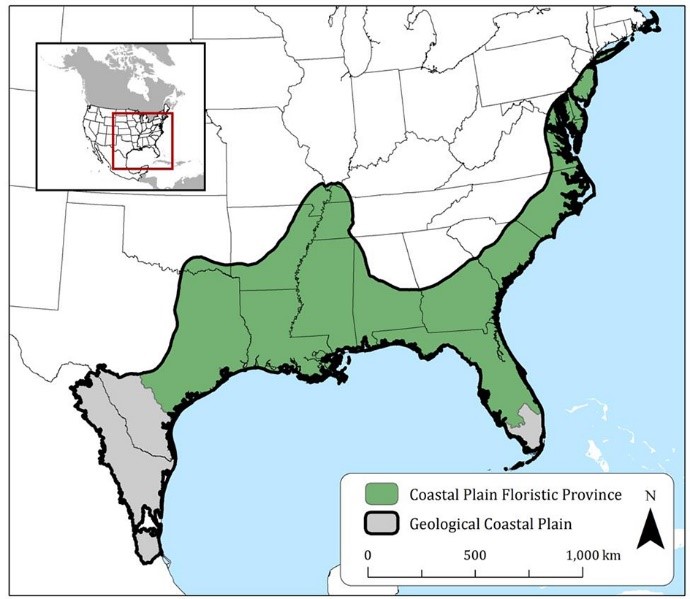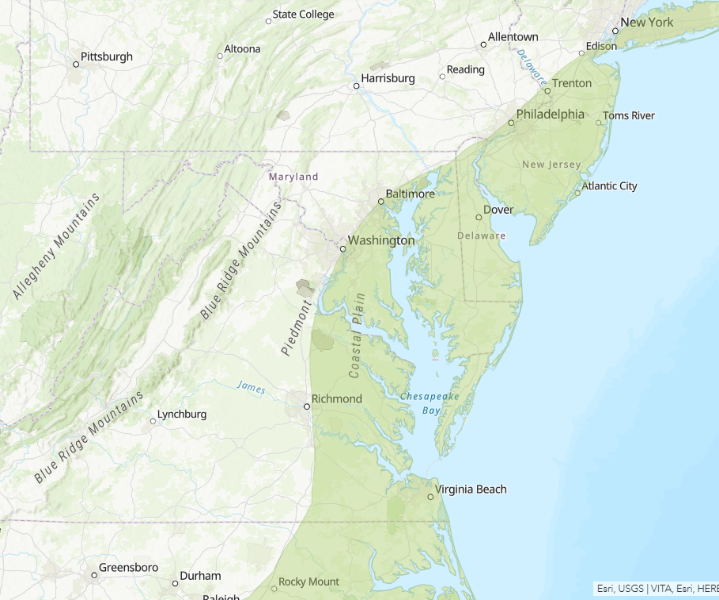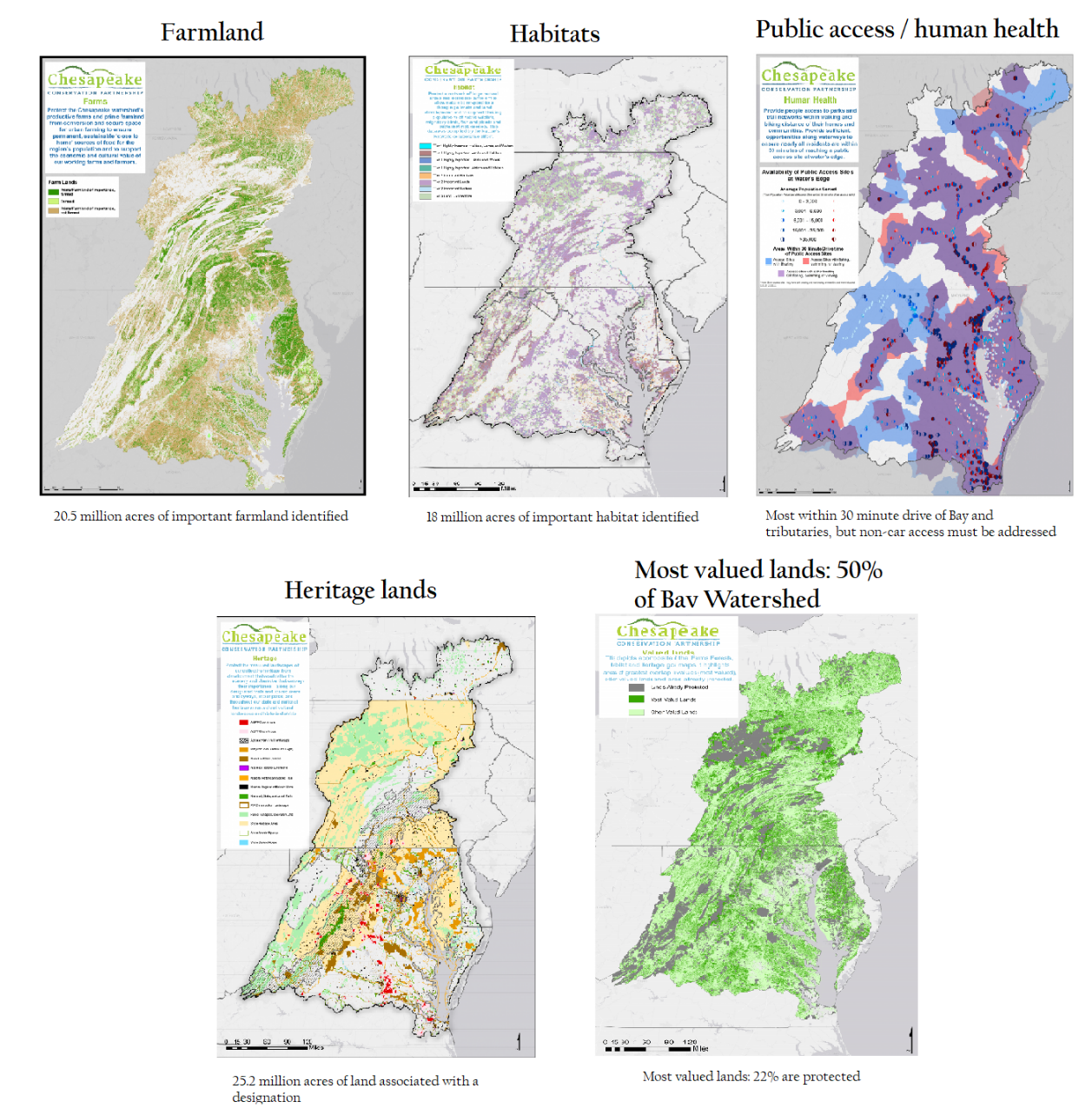Conserving 30% of the Chesapeake Bay watershed’s lands by 2030
Executive Summary
Chesapeake Conservancy believes that the Chesapeake conservation community must respond to a regional and global crisis which imminently threatens our natural areas and wildlife by committing to the protection of 30% of the Chesapeake Bay watershed by 2030.
Scientists from around the world have established clear and undeniable evidence of the impending threat to the world’s biodiversity. In the Chesapeake Bay, the environmental community has already devoted substantial resources toward land protection for the health of the Bay, its rivers, and our forests and habitats, but conservationists acknowledge the need to increase efforts in the face of a growing population and rapid land use change.
Regional conservation organizations, such as the Eastern Shore Land Conservancy, who are pursuing a 50% by 2030 strategy for the Delmarva peninsula, are beginning to adopt and pursue pursuing large landscape conservation goals.
Chesapeake Conservancy is calling for a regional effort to protect 30% of the Chesapeake Bay watershed by pursuing a precision conservation approach that would optimize resources and protect lands with the greatest value for water quality, outdoor recreation, wildlife habitat, and local economies. A precision conservation approach for 30 x 30 in the Chesapeake Bay will target funds toward high-value lands and set a landscape-scale model for other landscapes to follow.
Background: a global crisis of ecosystem degradation and biodiversity loss
Conservation scientists are in nearly unanimous agreement that earth is currently in or is on the brink of a sixth mass extinction of biodiversity event.[1] Scientists have found that the current average rate of vertebrate species extinction, as compared to the background rate that would naturally occur due to competition and natural selection, is as much as 100 times or greater than the background extinction rate.[2] A 2019 report by the Intergovernmental Science-Policy Platform on Biodiversity and Ecosystem Services (IPBES) finds that of the estimated 8 million species in existence on earth, 1 million species currently face a significant threat of extinction.[3] Ten years ago, members of the United Nations agreed to a ten year strategic plan on targets for biodiversity conservation; in September 2020, the United Nations issued its Global Biodiversity Outlook report which found that countries had failed to meet any of the targets set forth in 2010.[4]
The primary causes of the increased rate of extinction include changes in sea and land use, the direct exploitation of organisms, global climate change, pollution, and invasive alien species.[5] More than one-third of the land surface and nearly 75 percent of all freshwater resources on earth are devoted to agricultural uses.[6]
To respond to this urgent and global crisis, scientists are calling for dramatic increases in conservation efforts and habitat protection at a global scale. Renowned biologist E.O. Wilson [please see statement issued February 23, 2022, regarding Dr. Wilson’s support of scientific racism] has called for half of the earth’s lands and waters to be dedicated to nature.[7] Another group of scientists, including Dr. Thomas Lovejoy of George Mason University, have called for the protection of 30 percent of the earth by 2030, along with an additional 20 percent of the earth designated as climate stabilization areas, as a milestone to conserving half of the planet by 2050.[8] The “Global Deal for Nature” proposes these conservation targets as the threshold needed to protect biodiversity, mitigate climate change, and to reduce threats to ecosystems and the persistence of species.[9]
A movement to achieve 30 percent by 2030 has gained considerable traction on the national level in the United States. In 2019, Senators Tom Udall (D-NM) and Michael Bennet (D-CO) introduced a resolution for a national goal of conserving 30 percent of U.S. lands and 30 percent of the ocean within U.S. territory by 2030.[10] This resolution was also adopted in the official Democratic Party platform for 2020.[11] In October 2020, Governor Gavin Newsom of California announced that the state would adopt a 30% by 2030 goal for California lands and waters.[12]
The case for conservation in the Chesapeake Bay watershed
Ecological importance: The largest estuary in the United States, the Chesapeake Bay is one of the most biologically productive environments in the world and the Bay watershed is home to more than 3,600 species of animals and plants.[13] The Bay itself is one of the most productive fisheries in the United States and contributes about one-third of the nation’s total blue crab harvest.[14] The Chesapeake Bay watershed is also the winter home to one million waterfowl, including ducks, geese, and swans.[15]
A significant portion of the Chesapeake Bay watershed is included in one of the United States’ two biodiversity hotspots: the North American Coastal Plain (NACP).[16],[17] The NACP includes 1,800 endemic plant species, 51 endemic bird species, and 114 endemic mammal species. An estimated 85.5 percent of natural vegetation in the NACP has been significantly altered or developed for human use.

Image 1: North American Coastal Plain Biological Hotspot

Image 2: Chesapeake Bay watershed within NCAP
Images from Critical Ecosystem Partnership Fund
Land conservation helps to protect and restore the Chesapeake’s many and diverse habitats, and in turn helps to protect and restore biological diversity in the Chesapeake’s ecosystems.
The conservation of forested lands and other natural lands provides additional economic benefits. Conserved lands provide multiple ecosystem services that directly benefit human health and well-being. For example, forests deliver water pollution treatment, water flow regulation, and air pollution treatment benefits. A study on ecosystem service benefits of the Chesapeake Bay region finds that forests provide $74 billion dollars in benefits per year.[18]
Why 30 percent by 2030 in the Chesapeake Bay watershed?
Land conservation and the protection of forest, wetland, and other ecosystems is integral to the restoration and protection of the Chesapeake Bay. The 2014 Chesapeake Bay Watershed Agreement set a goal of conserving an additional 2 million acres in the watershed by 2025, or about 24% of the total watershed. In the 2019 Marking Milestones report, the Chesapeake Conservation Partnership estimates that the conservation community has achieved 68% of this goal, protecting 1.36 million acres since 2010.[19] This is a remarkable achievement in and of itself, but the Partnership also recognized the increasing stress on nature due to a growing population and other environmental stressors that threaten the region’s nature and wildlife. Population projections of 20 million or more within the Bay watershed, increased land use change and development, and projections for increased precipitation and severe weather events due to climate change will all have a substantial negative impact on water quality in the watershed, as well as on habitats for terrestrial and bird wildlife.
For these reasons, and in the context of the global biodiversity crisis, Chesapeake Conservancy believes it is appropriate and feasible to pursue a 30% by 2030 conservation objective for the Chesapeake Bay watershed.
Which 30 Percent?
Considering the diverse set of benefits and concerns related to land use, there are several priorities which would allow the conservation community to focus its efforts in conserving the remaining 8% of the Chesapeake watershed to achieve 30% by 2030. These priorities range in importance according to the Bay’s incredibly diverse geography and its populations. The types of legal protections that would be pursued in order to conserve these lands would also vary based on land use. The Chesapeake Conservation Partnership has identified priority lands in the Chesapeake, focusing on five categories: farms, forests, habitat, human health, and heritage. Lands identified according to the Partnership’s criteria represents about 50% of the entire Chesapeake watershed.

Along with the values identified by the Chesapeake Conservation Partnership, there are other values and ecosystem benefits that should be incorporated into a 30 x 30 strategy for the Chesapeake Bay, such as environmental justice and water quality. Chesapeake Conservancy believes that we must optimize resources dedicated to conservation by prioritizing lands that would result in the greatest number of benefits (water quality, habitat, outdoor recreation, etc.), and challenges the conservation community to focus its collective efforts according to this precision conservation approach.
Achieving 30 Percent
Community buy-in
Conserving 30% of the Chesapeake Bay watershed, and prioritizing lands to maximize benefits, will require the participation of many stakeholders. The Chesapeake Conservation Partnership and its members are principal to this objective, and must adopt 30 x 30 as the next top goal for the partnership. In turn, it is important that the greater Chesapeake community recognizes the relevance and importance of achieving 30% for the health of the Chesapeake Bay and its tributaries. Therefore, the Chesapeake Bay Program should adopt 30 x 30 as a formal goal.
Prioritization
Chesapeake Conservancy seeks to play a leading and collaborative role in helping conservation partners to prioritize efforts through its Conservation Innovation Center.
Enhanced resources
Achieving this goal also requires that both public and private funding is defended and scaled-up.
Public funding remains the most significant source of conservation funding, and public funding from the federal government, state governments, and local governments must increase in order to meet the increased demand for conservation. Several programs have received significant increases in recent years, which will greatly benefit the Chesapeake Bay watershed.
- Federal programs:
- Land and Water Conservation Fund: The Land and Water Conservation Fund provides funding for federal land acquisition (National Park Service, Bureau of Land Management, U.S. Fish and Wildlife Service, U.S. Forest Service) and for state and local park acquisition and development. In 2020, Congress passed the Great American Outdoors Act, which makes LWCF appropriations mandatory and which will fund LWCF at $900 million each year.
- In the past twenty years, the Chesapeake Bay watershed has received about $100 million in LWCF funding (federal side), along with tens of millions of dollars more in state funding. The Great American Outdoors Act will strongly boost funding for both federal land conservation and state and local conservation efforts.
- Agricultural Conservation Easement Program (Farm Bill): According to the USDA, ACEP “helps landowners, land trusts, and other entities protect, restore, and enhance wetlands, grasslands, and working farms and ranches through conservation easements.”[20]
- North American Wetlands Conservation Act: According to the U.S. Fish and Wildlife Service, “the NAWCA program provides matching grants to wetlands conservation projects in the United States, Canada, and Mexico.”
- As of 2018, NAWCA has supported 29 projects in Pennsylvania, across 55,430 acres, through $19 million in grants. Partners matched NAWCA grants with an additional $71 million.
- In Maryland and as of 2018, NAWCA has supported 24 projects across 50,332 acres, through $14.7 million in grants and $58.6 million in matched partner funds.
- In Virginia and as of 2018, NAWCA has supported 29 projects across 55,430 acres, through $19 million in grants and $71 million in matched partner funds.
- In Delaware and as of 2018, NAWCA has supported 10 projects across 10,803 acres, through $6 million in grants and $12.6 million in matched partner funds.
- Land and Water Conservation Fund: The Land and Water Conservation Fund provides funding for federal land acquisition (National Park Service, Bureau of Land Management, U.S. Fish and Wildlife Service, U.S. Forest Service) and for state and local park acquisition and development. In 2020, Congress passed the Great American Outdoors Act, which makes LWCF appropriations mandatory and which will fund LWCF at $900 million each year.
- State programs:
- Maryland: In Maryland and in FY19, $145 million was allocated to land protection
- Program Open Space
- Rural Legacy Program
- Maryland Agricultural Land Preservation Foundation
- Virginia: In Virginia and in FY19, $62 million was allocated to land protection
- Land Preservation Tax Credit
- Virginia Outdoors Foundation
- Virginia Land Conservation Foundation
- Battlefield Preservation Fund
- Farmland Preservation Fund
- Mitigation
- Pennsylvania: In Pennsylvania and in FY19, $46 million was allocated to land protection
- Keystone Recreation, Park and Conservation Fund
- Oil and Gas Lease Fund
- Environmental Stewardship Fund
- Farmland Preservation
- Greenways, Trails and Recreation Program
- Watershed Restoration and Protection Program
- Delaware: In Delaware and in FY19, $19 million was allocated to land protection
- Open Space Program
- Agricultural Lands Preservation Program
- Forestland Preservation Program
- Young Farmers Program
- West Virginia: In West Virginia and in FY19, $5 million was allocated to land protection
- Farmland Protection Program
- Outdoor Heritage Conservation Fund
- DNR Wildlife Resources Land Acquisition
- Mitigation
- New York: In New York and in FY19, $74 million was allocated to land protection.
- Open Space Program
- Agricultural and Farmland Protection Program
- Park, Recreation & Historical Preservation
- Source Water Protection
- Maryland: In Maryland and in FY19, $145 million was allocated to land protection
Public funding alone will not be sufficient in order to achieve 30 x 30 in the Chesapeake Bay, and often public funding requires matching funding from private sources. There are several market-based options that can draw private capital into conservation in the Chesapeake Bay
- Mitigation banking: Several mitigation banking firms operate within the Chesapeake Bay watershed and have completed restoration projects that include conservation easements. Through the completion of restoration projects, mitigation banks generate credits that can be purchased by private and public entities who must comply with mitigation requirements from projects with environmental impacts.
- Carbon credits: The voluntary carbon market and California carbon market have enabled additional means to achieve conservation through projects that sequester carbon and generate credits. Forest land, agricultural lands, and wetlands in the Chesapeake Bay all sequester carbon, and there is strong potential for the development of a credit market that would enable private investment in conservation projects.
What is being done today?
Chesapeake Conservancy has been selected for a client-based Master’s Project for Duke University’s Nicholas School of the Environment that will engage four graduate students in research to help Chesapeake Conservancy build the scientific and economic case for 30 x 30 in the Chesapeake Bay. Students will complete their research over the academic year and present findings in April 2021.
Summary
Conserving 30% of the Chesapeake Bay watershed by 2030, and prioritizing conservation efforts to maximize benefits for nature and for people, is an appropriate and feasible goal for the conservation community. To address the current stresses on wildlife, ecosystems, working lands, and the Bay itself, and to prepare for a future with even greater impacts on nature in the region, the conservation community should adopt a 30% by 2030 goal for the Chesapeake. Targeting our shared conservation efforts can improve the health of rivers and streams, it can expand access to recreational opportunities, it can protect farms and forests, and it can preserve the heritage of our unique and treasured landscape.
[1] American Museum of Natural History. “National Survey Reveals Biodiversity Crisis – Scientific Experts Believe We Are In Midst Of Fastest Mass Extinction In Earth’s History.” April 20, 1998. http://www.mysterium.com/amnh.html
[2] Ceballos, Gerardo et al. Accelerated modern human-induced species losses: Entering the sixth mass extinction.” Science Advances 19 June 2015: Vol. 1, no. 5. https://advances.sciencemag.org/content/1/5/e1400253
[3] Diaz, Sandra et al. “Summary for policymakers of the global assessment report on biodiversity and ecosystem services.” Intergovernmental Science-Policy Platform on Biodiversity and Ecosystem Services.”
[4] Yeung, Jessie. “The world set a 2020 deadline to save nature but not a single target was met, UN report says.” CNN. September 16, 2020 https://www.cnn.com/2020/09/16/world/un-biodiversity-report-intl-hnk-scli-scn/index.html
[5] Ibid.
[6] Ibid.
[7] E.O. Wilson Biodiversity Foundation. “Half-Earth: Our Planet’s Fight for Life.” https://eowilsonfoundation.org/half-earth-our-planet-s-fight-for-life/
[8] Dinerstein, Eric et al. “A Global Deal for Nature: Guiding principles, milestones, and targets.” Science Advances 19 April 2019. Vol. 5, no. 4. https://advances.sciencemag.org/content/5/4/eaaw2869#:~:text=The%20Global%20Deal%20for%20Nature,abundance%20of%20life%20on%20Earth.&text=The%20GDN%20targets%2030%25%20of,stay%20below%201.5%C2%B0C.
[9] Ibid.
[10] The Office of Senator Tom Udall. “Udall, Bennet Introduce Major Resolution to Set National Conservation Goal: Conserve 30% of U.S. Lands and Ocean by 2030.” 22 October 2019. https://www.tomudall.senate.gov/news/press-releases/udall-bennet-introduce-major-resolution-to-set-national-conservation-goal-conserve-30-of-us-lands-and-ocean-by-2030#:~:text=introduced%20a%20major%20Senate%20resolution,has%20reached%20a%20tipping%20point.
[11] David Shiffman. “How to Revolutionize Biodiversity Conservation in the U.S.” Scientific American. 4 October 2020. https://www.scientificamerican.com/article/how-to-revolutionize-biodiversity-conservation-in-the-u-s/
[12] Paul Rogers. “Newsom announces plan to conserve 30% of California’s land and coastal waters.” The Mercury News. 7 October 2020. https://www.mercurynews.com/2020/10/07/newsom-announces-plan-to-conserve-30-of-californias-land-and-coastal-waters/
[13] Lindsay Eney. “Why is the Chesapeake Bay so important?” Chesapeake Bay Program. 22 October 2010. https://www.chesapeakebay.net/news/blog/why_is_the_chesapeake_bay_so_important. Accessed 7 April 2020.
[14] “Our Treasured Ecosystem.” Maryland Department of the Environment. https://mde.maryland.gov/programs/Water/TMDL/TMDLImplementation/Pages/what-is-the-bay.aspx#why_is. Accessed 7 April 2020.
[15] “Chesapeake Bay.” The National Wildlife Federation. https://www.nwf.org/Educational-Resources/Wildlife-Guide/Wild-Places/Chesapeake-Bay. Accessed 7 April 2020.
[16] Critical Ecosystem Partnership Fund. “Biodiversity Hotspots in the United States.” Critical Ecosystem Partnership Fund. https://www.cepf.net/our-work/biodiversity-hotspots/north-american-coastal-plain. Accessed 6 April 2020.
[17] A biodiversity hotspot is defined as a region with exceptional biodiversity that has been significantly impacted by land use change. A biodiversity hotspot must contain at least 1,500 species of endemic vascular plants and it must have lost at least 70 percent of its original surface area to development
[18] Spencer Phillips & Beth McGee (2016): Ecosystem Service Benefits of a Cleaner Chesapeake Bay, Coastal Management, DOI: 10.1080/08920753.2016.1160205
[19] Chesapeake Conservation Partnership. “Marking Milestones: Progress in conserving land in the Chesapeake Bay watershed.” 2019. https://www.chesapeakeconservation.org/wp-content/uploads/2019/08/CCP_publication_SD_FD-R-FINAL.pdf
[20] https://www.nrcs.usda.gov/wps/portal/nrcs/main/national/programs/easements/acep/